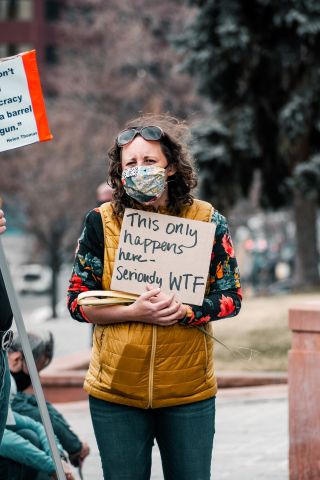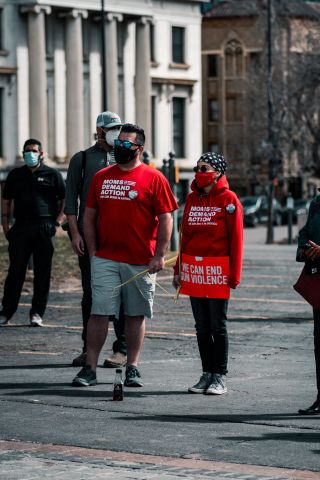KEY POINTS-
- False beliefs and poor knowledge about firearms and mass shootings may contribute to failed prevention.
- Mass shooters may have histories of trauma, suicidality, and violent crime, and tend to leak their plans.
- Common motivations for mass shooters include a desire for fame/infamy, following other shooters, and seeking to cause widespread harm.
- Policy evidence for mass shooting prevention is limited and in need of further study.

Another week, another news-making mass shooting, this time in Allen, Texas. These types of events tend to bring about a number of typical responses in public conversation:
- “What about black-on-black crime?”
- “Arm the public and this wouldn’t happen!”
- “I could shoot the shooter before they could get me!”
- “Kids aren’t raised right these days!”
- "What about liberal cities?"
Recent conversational gems from lay conservatives, medical practitioners, and others have provided fruitful examples of the ignorance that pervades public discourse on mass shootings. Indeed, basic facts like elevated risk for gun-related death in rural areas and conservative states appear to escape the masses. Such false narratives and practiced talking points can contribute to the inability to prevent mass shootings. In light of the vital need to address this growing violent trend, it begs the question: What do we really know about mass shootings?
There are at least three major takeaways from the current science on mass shootings and related firearm violence.
1. Many people don’t know much about gun-related matters. Knowledge is power. If that is the case, one cause of our lack of progress in preventing mass shootings may be very apparent: We’re uninformed. One study surveying 1518 students across three universities showed that the average student knowledge was about 69% accurate on a basic true/false firearm knowledge test. That's a D+. Not very good.
Mental health professionals are often involved in the removal and restoration of firearm rights. This pivotal role could be implicated in the prevention of future firearm violence, including mass shootings. Troublingly, a statewide survey of psychiatrists showed that less than half possessed basic knowledge on most basic, yet important, firearm-related assessment practices (e.g., who can perform an evaluation for restoration of gun rights).
Forensic practitioners have lamented this widespread lack of firearm knowledge and cultural competence. In doing so, they call for and provide a path toward firearm cultural competence training for mental health professionals.
2. We have some insight into the characteristics of perpetrators and events. The science depicting characteristics of these events is relatively new, but growing. A Department of Justice research summary lends insights to this point. Key takeaways:
- The demographic make-up of shooters is mostly White males with an average age of 35. Other common demographics included having a prior history of violence and a criminal record.
- Although sites of mass shootings vary, the most common locations in descending order were workplaces, retail stores, and bars/restaurants.
- States of trauma and crisis, as well as recent suicidality, were somewhat common leading up to mass shootings.
- Most mass shootings occur using handguns that are legally purchased.
- Warning signs include leaking details of the shooting to other persons or via manifestos prior to the event.
3. We have some understanding of changing shooter motivations over time. Research about event and perpetrator characteristics is a good start. However, it has limited value with regard to preparing prevention and intervention strategies. A deeper understanding of motivations for mass shootings may lend such insights. A pair of criminologists conducted an important study identifying changes in motivations for mass shootings. They provided a model for mass shootings, highlighting that societal trends in the last 50 years may impact shooter motivations. The following societal shifts are thought to impact shooter motivation: an increased desire for attention/fame, greater conflation of fame with infamy, a notable rise in the sheer number of mass shootings, and heightened ease of access to guns.
The combination of social influences shows clear motivations among mass shooters. First, mass shooters may seek increased infamy and attention. Second, mass shootings may result from contagion or the influence of prior mass shooting events. Third, mass shooters likely seek to inflict more death over time.

Where do we go from here?
A budding science on guns and mass shootings shows that our knowledge base, widely defined, is in its infancy. At the same time, it’s obvious we need more than just “thoughts and prayers” from politicians to remedy the problem. We need evidence-informed policy. To this end, firearm science offers us two next steps.
First, we can follow the science on firearm policy. Policy summaries exist in key areas such as firearm suicide prevention. Other science can be generally informative to mass shooting prevention. For instance, the RAND Corporation provided a fairly comprehensive review of gun laws and a variety of firearm-focused outcomes (e.g., mass shootings, violent crime, unintentional injuries). Several findings are relevant to this discussion.
Overall, the following types of gun policies showed moderate-to-high levels of evidence to reduce violent crime: prohibitions related to domestic violence, surrendering of guns by prohibited persons, background checks, waiting periods, child access prevention laws, concealed carry laws, and stand-your-ground laws. To the extent these laws can impact firearm deaths, they seem to be an evidence-informed start for mass shooting prevention.
Notably, in Rand's review no policies showed such a high level of support for mass shooting prevention specifically, while only assault weapon/high capacity magazine bans showed any promise in this area. It’s not all bad news in terms of policy-focused prevention of mass shootings, however. A policy analysis of the Federal Assault Weapons Ban showed that it was associated with a meaningful reduction in mass shootings during the decade it was in place. The federal ban, however, expired in 2004 and has not been renewed.
The limited effective evidence-informed policy begs for a second next step: A clear research agenda. Policy scholars from Vanderbilt University charted a course to guide the next steps in gun violence policy and prevention research. They identify four specific guiding tenets. First, the field must focus on cultural and contextual drivers of violence over notions of lone wolves or random shootings. Second, the impact of race and racial bias in links between mental illness and gun violence must be disentangled. Third, an approach integrating legal, cultural, psychological, and other perspectives is needed to further the study of firearm ownership and mass shootings. Finally, especially in light of documented upticks in firearm sales due to fear and anxiety, mass shooting and other violence prevention research should involve a variety of partnerships and stakeholders. This call to action is a valuable roadmap for moving mass shooting prevention forward.



